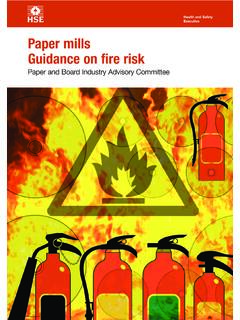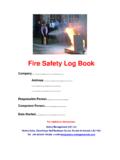Transcription of Fire safety engineering concerning evacuation from …
1 fire safety engineering concerning evacuation from buildingsCFPA-E Guideline No 19:2009 F CFPA-E -GUIDELINES EFSAC Endorsed FOREWORD The European fire protection associations have decided to produce common guidelines in order to achieve similar interpretation in European countries and to give examples of acceptable solutions, concepts and models. The Confederation of fire Protection Associations in Europe (CFPA E) has the aim to facilitate and support fire protection activities across Europe/work in European/work in the European countries. The market imposes new demands for quality and safety . Today, fire protection forms an integral part of a modern strategy for survival and competitiveness.
2 This guideline is primarily intended for those responsible for safety in companies and organisations. It is also addressed to the rescue services, consultants, safety companies etc so that, in the course of their work, they may be able to help companies and organisations to increase the levels of fire safety . The proposals within this guideline have been produced by the AIAS - Associazione professionale Italiana Ambiente e Sicurezza and the author is Tiziano Zuccaro from Italy. This guideline has been compiled by Guidelines Commission and adopted by all fire protection associations in the Confederation of fire Protection Associations Europe. These guidelines reflect best practice developed by the countries of CFPA Europe.
3 Where the guidelines and national requirement conflict, national requirements must apply. Z rich, , 8 June 2009 Stockholm, 8 June 2009 CFPA Europe Guidelines Commission Dr. Hubert R egg Tommy Arvidsson Chairman Chairman 3 GUIDELINE No 19:2009 CFPA-E -GUIDELINES EFSAC Endorsed U1U 4 U2U U3U UKey 4 U4U UPrescriptive approach to 8 U5U UEngineering approach: evaluation of evacuation safety 8 8 UASET time 9 9 UFire 9 UDesign fire 10 UCalculation of design fire 10 URSET time 12 12 13 U6U UEuropean 13 UAnnex A: Physiological effects of exposure to 14 UAnnex B: Definitions and characteristics of fire 17 UAnnex C: Considerations regarding the principal fire simulation 22 UAnnex D: Calculations of RSET 25 UAnnex E: Main characteristics of evacuation 42 4 GUIDELINE No 19.
4 2009 CFPA-E -GUIDELINES EFSAC Endorsed 1 0 BIntroduction Saving human life is the most important objective in fire protection processes. Proper evacuation plans are essential to reach this objective. Two methods can be considered: The first is the prescriptive method which deals with the size and number of exits together with the maximum length of the escape routes; The second is the performance method which deals with the maximum time limit for evacuation . The first method is based on three main points: density of people; flow of people; length and width of evacuation routes. The second method establishes if the required evacuation time is less than available safety egress time.
5 2 1 BScope The main scope of this guideline is to supply valid support for the evacuation strategy to allow occupants, anywhere within the structure, to be able to evacuate to a place of safety . 3 2 BKey terms Accessibility The accessibility of an item or a product related to a specific risk concerns the degree of proximity of the user to the item or product, where the risk can occur. Depending on the particular risk, this concept may concern a person or only a part of his/her body ( hand, finger) or even a thing handled by a person, and applies to the possibility of contact (shocks, hot surfaces etc.) or critical distances (electrical shocks, radiation, etc.). Actions Actions which may affect the compliance of the works with the essential requirements are brought about by agents acting on the works or parts of the works.
6 Such agents include mechanical, chemical, biological, thermal and electro-magnetic agents. Active fire protection measures Systems and equipment installed to reduce danger to persons and property by detecting fire , extinguishing fire , removing smoke and hot gases, or any combination of these functions. 5 GUIDELINE No 19:2009 CFPA-E -GUIDELINES EFSAC Endorsed Alarm Sudden attention or action for protection of persons or property (ISO 8201, 1987) Critical conditions for occupants Limit values for temperature increase, oxygen depletion and concentration of toxic combustion gases that seriously endanger life safety in a certain time Design fire scenario A design fire scenario is a subsystem of fire scenarios and represents the most probable or onerous of them.
7 They are a specific fire scenario on which an analysis will be conducted. Emergency Imminent risk of serious threat to person or property Escape route Route forming part of the means of escape from any point in a building to a final exit Available safe egress time (ASET) Calculated time available between ignition of a fire and the time at which tenability criteria are exceeded in a specific space in a building Escape time Calculated time from the ignition until the time at which all the occupants of a specified part of a building are able to reach place of safety evacuation time In relation to the orderly movement of persons to a place of safety in case of fire or other emergency this is the interval between the time of a warning of fire being transmitted to the occupants and the time at which all of the occupants are able to reach a place of safety .
8 Exit ( fire emergency) Doorway or other suitable opening giving access towards a place of safety Exit signs Signs which clearly indicate an exit fire A process of a combustion characterised by emission of heat accompanied by smoke and / or flame Rapid combustion spreading uncontrolled in time and escape fire alarm installation Combination of components for giving and audible and / or visible and / or other perceptible alarms of fire . The system may also initiate other ancillary actions. 6 GUIDELINE No 19:2009 CFPA-E -GUIDELINES EFSAC Endorsed fire alarm, alarm of fire Warning of a fire originated by a person or by an automatic device. fire rescue team Public or private organisation with the aim of safeguarding life and fighting fires.
9 fire compartment An enclosed space in a building that is separated from other parts of the same building by enclosing construction having a specified period of fire resistance, within which a fire can be contained (or from which a fire can be excluded), without spreading to (or from) another part of the building . fire detector Device which give a signal in response to certain physical and /or chemical changes accompanying a fire . fire door A door or shutter, which, together with its frame and furniture as installed in a building , when closed is capable of meeting specified performance criteria. fire exposure Thermal actions affecting the product. fire hazard The potential to lose a life (or injury) and / or damage a property by fire .
10 fire resistance The ability of an element of a building construction to fulfil for a stated period of time the required load bearing function, integrity and / or thermal insulation specified in the standard fire resistance test. fire risk level A function relating to the probability of fire causing a loss of life (or injury) and / or damage the property and the degree of harm caused. fire safety installations Those installations concerned with services, alarm and detection, installations for means of escape, suppression and fire fighting equipment. fire scenario A qualitative description of the course of a fire with time, identifying key events that characterise the fire and differentiate it from other possible fires It typically defines the ignition and fire growth process, the fully developed stage and the decay stage, together with the building environment and systems that will impact on the course of the fire .







